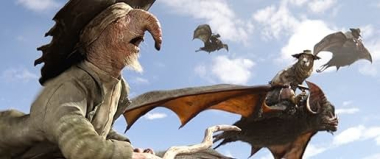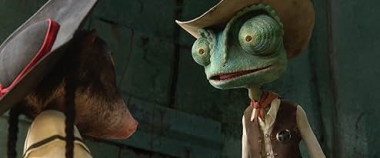Rango Review
My Unexpected Journey into the Wild West
I vividly remember the first time I sat down to watch Rango. The moment the opening credits rolled, I was transported into an inventive, sun-soaked universe that felt simultaneously familiar and utterly bizarre. As someone with a deep appreciation for animation that dares to experiment with both aesthetic and storytelling, I found myself leaning forward in anticipation of what the film had in store. My experience was not merely about watching a movie; it was about embarking on a journey into a beautifully anarchic world where everything from the smallest detail to the broadest narrative stroke worked together in delightful harmony.
A World of Unconventional Characters
Throughout the film, I was struck by the richness and depth of the characters. Each figure, from the quick-witted chameleon protagonist to the motley crew of outlaws and desert denizens, had a distinct personality, and their interactions felt refreshingly spontaneous. I appreciated the way the movie balanced moments of introspection with bursts of humor, inviting me to reconsider what I expected from animated characters. The voice acting, headlined by a charismatic performance, imbued the film with layers of subtlety that resonated within me long after the screen faded to black.
Animation as an Art Form
The artistry of Rango captivated my eyes and heart. I found that every frame seemed to be meticulously painted with intent. The textures of the arid landscape, the exaggerated expressions of the characters, and the surreal blend of shadow and light all contributed to an aesthetic that was simultaneously deranged and charming. It was as if the animators deliberately layered details one atop the other to build a world that was as gritty as it was colorful. This precision in animation felt like experiencing a moving painting that was constantly evolving, and I was more than willing to gaze into its details repeatedly.
Humor That Hit Close to Home
The humor embedded within Rango was something I had not anticipated but thoroughly enjoyed. There were moments when the clever quips and situational comedy made me laugh out loud, resonating with the absurdity of life itself. I found that these humorous moments were never at the expense of deeper narrative elements; rather, they worked in tandem with the emotional arcs of the characters, adding layers of complexity to what might otherwise have been a straightforward tale. For me, this blend of comedy and existential musings was a refreshing twist that elevated the overall experience.
Sound and Silence in Perfect Harmony
The film’s auditory landscape was equally remarkable. As I watched, I became increasingly aware of the careful balance between sound and silence that governed each scene. The soundtrack, melding scores of rustic tex-mex tunes with an undercurrent of tension, accentuated the visual storytelling without overwhelming it. I found particular delight in how sound was used not only to set the atmosphere but also to emphasize the inner workings of the characters’ emotional journeys. There were moments when the soundscape itself seemed to narrate the unfolding story, and that unique interplay between audio and action kept me thoroughly engaged throughout the movie.
The Intricacies of Storytelling
From its opening sequences to the more complex middle chapters, the narrative of Rango unfolded like a parable set in the heart of a troubled desert town. I was fascinated by how the film managed to weave multifaceted themes such as identity, authenticity, and transformation into a storyline that never lost its pace. Every subplot and character arc interlocked in a way that demanded my attention, urging me to pause, reflect, and even laugh at unexpected revelations. As I navigated through the narrative, I found myself drawn into debates about morality, fate, and the unpredictable nature of existence—all wrapped in a package that was as visually captivating as it was intellectually stimulating.
Dynamic Pacing and Rhythmic Momentum
One aspect of Rango that particularly resonated with me was its dynamic pacing. The film seemed to oscillate between moments of rapid fire action and quiet, introspective pauses. This rhythmic alternation maintained a tension that not only highlighted the unpredictability of the storyline but also kept me continuously involved in the unfolding events. I was convinced that each scene, no matter how brief or elaborate, was deliberately designed to evoke a reaction, whether that be a rush of adrenaline or a deep, reflective silence. This careful calibration of pacing allowed me to appreciate the cinematic craftsmanship on multiple levels.
Visual Storytelling That Challenges Conventions
What set Rango apart was the bold risk it took in its approach to visual storytelling. I was particularly drawn to the unconventional camera angles, the imaginative use of color, and the overall willingness of the film to challenge traditional narratives. Every shot seemed to be consciously designed to defy my expectations and lead me into uncharted territories of creative expression. Whether it was a surreal sequence punctuated by rapid cuts or a lingering scene that allowed the mood to sink in, I felt that the film was not just about narrating an old Western tale but about reinventing it piece by piece.
Emotional Depth in Unexpected Places
Despite its offbeat humor and striking visuals, Rango did not shy away from exploring the vulnerabilities of its characters. I found moments where the film shifted unexpectedly from a whimsical romp to an introspective examination of self-discovery. This emotional duality reminded me that beneath the layers of satire and lightning-fast dialogue lay a deeper narrative of growth, hope, and existential questioning. In those fleeting moments of raw honesty, I recognized a vulnerability that is seldom found in animated adventures, making the film feel both personal and monumental.
Cultural Nuances and Historical Echoes
As I immersed myself further, I became increasingly aware of the cultural and historical references interwoven throughout the movie. Rango drew on a rich tapestry of Western folklore and desert lore, reinterpreting them in a modern context that was both inventive and respectful of tradition. I was particularly intrigued by how ancient motifs and contemporary issues were balanced seamlessly, inviting me to ponder the ways in which art can serve as a bridge between eras. This melding of cultural nuances with the thematic struggles of the characters enriched my viewing experience and invited multiple layers of interpretation.
The Spectacle of Desert Life
The environment of the film, a harsh yet entrancing desert town, was rendered with such attention to detail that I found myself marveling at the sheer ingenuity behind its creation. The arid landscapes were not merely backdrops but active participants in the narrative, almost echoing the internal states of the characters. Every dust cloud, every sun-dappled canyon, and every forgotten outpost whispered stories of resilience and heartache. I felt as though I was walking beside the characters through an ever-changing canvas that both reflected and challenged their personal quests for meaning. This vivid portrayal of desert life became a lens through which I observed the interplay of nature and narrative, deepening my engagement with the world on screen.
Subtle Political Undertones and Social Commentary
Throughout my viewing, I was continually impressed by the film’s ability to infuse its storyline with subtle political undertones and incisive social commentary. Rango did not merely serve as an escapist adventure; it gently prodded at the socio-political dynamics of power, marginality, and rebellion. I remember being particularly moved by the nuanced ways in which authority and its misuse were depicted, echoing contemporary debates on equity and justice. The film’s satirical approach to these weighty topics, wrapped in humor and visual extravagance, encouraged me to reflect on the broader narratives of society without ever feeling preachy or didactic. This persistent layer of commentary elevated my understanding of the film as both entertainment and an allegory for change.
Innovative Use of Animation Techniques
Rango’s technical prowess in animation was nothing short of groundbreaking. I was fascinated by how the film combined traditional techniques with modern digital effects, resulting in a style that was both nostalgic and cutting-edge. The seamless integration of hand-drawn textures with sophisticated CGI created a visual experience that was immersive and truly original. I could sense that every frame was a labor of love, meticulously designed to push the boundaries of what animation could achieve. Watching the film, I found myself admiring not just the story and characters, but also the sheer audacity of its artistic ambition, which left a lasting impression on me as a lover of innovative cinema.
Unexpected Emotional Resonance
Perhaps one of the most surprising aspects of my experience with Rango was the emotional resonance that emerged from its most unexpected scenes. Amid the riot of color, humor, and action, there were moments of poignant vulnerability that caught me off guard. I remember one scene in particular where the protagonist’s internal battle was rendered with such intensity that I found my heart unexpectedly tender. The artful juxtaposition of whimsical antics against genuine, heartfelt emotion made the experience deeply personal. Each laugh, every tear, and every moment of reflective silence added layers of meaning to the narrative that I found both challenging and profoundly moving.
Interactive Layers and Audience Engagement
While Rango is fundamentally a cinematic experience, I couldn’t help but feel an interactive connection throughout its runtime. There was a palpable sense of invitation, as if the film was daring me to engage with its narrative puzzles and symbolic imagery. I found myself piecing together subtle clues and pondering alternative interpretations during the most intense segments. This interactivity, though not in the traditional sense of a game, resonated with my desire for cinema that does more than passively tell a story; it beckons the viewer to actively participate in its unfolding mysteries. In moments when I felt confronted by the film’s open-ended questions, I was reminded of the power of art to spark conversation and self-exploration.
Screenshots




Leave a comment
Your comment is awaiting moderation. We save your draft here
0 Comments